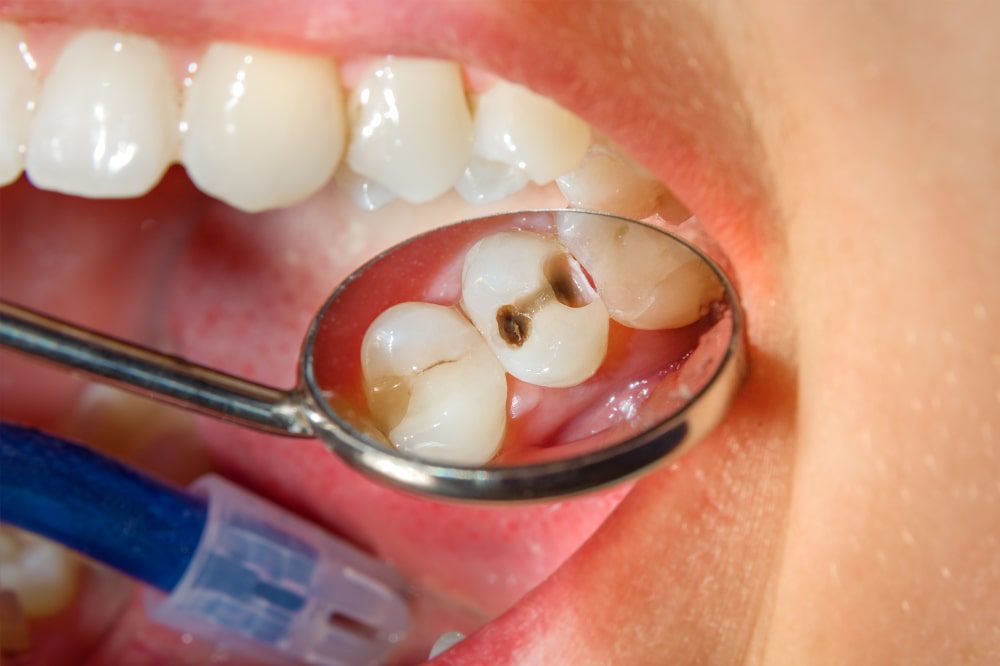Some home treatments, including fluoride toothpaste, won’t get rid of existing cavities, but they might help prevent new ones. If you want to remove a cavity, you might have to see a dentist. Dental cavities, also known as caries, are small holes in the hard surface of the teeth. They are mainly caused by bacteria on the surface of teeth creating acid out of sugar.
The most common culprit is a bacterium known as Streptococcus mutans. The bacteria create a sticky film known as plaque. The acids in plaque then remove the minerals from your enamel, which is a coating of the teeth made mostly of calcium and phosphate.
This erosion causes small holes in the enamel. Once the acid damage manages to spread into the dentin layer underneath the enamel, a cavity is created.

How to Get Rid of Cavities at Home
There are plenty of home treatments that originated from a study conducted in the 1930s, which suggested that cavities are caused by a lack of vitamin D in the diet. In this particular study, kids who incorporated vitamin D into their diets showed a significant reduction in cavities.
But those who added vitamin D while also removing grain products from their diets registered the best results. This is generally because grains can easily stick to the teeth. Well, not getting enough vitamin D could make the teeth more susceptible to cavities.
However, now we understand that this is just a small piece of the puzzle. Other risk factors for cavities could include:
- dry mouth or suffering from a medical condition that reduces the amount of saliva in the mouth
- eating foods that cling to teeth, such as candy or sticky foods.
- constant snacking on sugary foods or drinks, such as soda, cereals, and ice cream.
- heartburn
- inadequate cleaning of teeth
- bedtime infant feeding
As soon as a cavity has penetrated the dentin, you won’t be able to get rid of it with home remedies. The following home remedies could help prevent cavities or even treat “pre-cavities” by remineralizing weakened areas of your enamel right before a cavity develops. Here’s what we recommend:
Sugar-free gum
Chewing sugar-free gum after meals has been proven in many clinical trials to help remineralize enamel. Gum that has xylitol has been researched for a long time due to its amazing ability to stimulate saliva flow, raise the pH of plaque, and even reduce S. mutans.
Even so, prolonged studies are still needed. Sugar-free gum has a compound known as casein phosphopeptide-amorphous calcium phosphate (CPP-ACP), which has been proven to reduce S. mutans even more than chewing gum with xylitol. You can easily find this specific type of gum in stores, or you could simply get it from here.
Vitamin D
Vitamin D is very important when it comes to absorbing calcium and phosphate from the food you eat. Studies also showed an inverse relationship between eating foods high in vitamin D and calcium, such as yogurt, and cavities in young children.
You can easily get vitamin D from dairy products, such as milk and yogurt. You can also get vitamin D from the sun. Some of the most recent research has challenged how vitamin D can affect our dental health.
Brush with fluoride toothpaste.
Fluoride also plays a crucial role in preventing cavities and remineralizing enamel. Continuous research has been done to show how regularly brushing your teeth with fluoride toothpaste can prevent cavities. The vast majority of studies have been conducted either in children or adolescents, so we obviously need more research on adults and the elderly.
Cut out sugary foods.
This is the number-one cavity remedy that no one wants to try. Just stop eating so much sugar. The World Health Organization declared that eating sugar is the number one factor in cavities. They also recommend reducing your sugar intake to less than 10 percent of your total caloric intake for that day.
Or, if you’re going to have some sugar, make sure you don’t snack on sugary foods throughout the day. As soon as the sugar is gone, your enamel might have a chance to remineralize. However, if you are consistently eating it, your teeth won’t get the chance to remineralize.
Oil pulling
Oil pulling is an ancient practice that involves swishing around the oil, whether it’s sesame or coconut, in your mouth for 20 minutes, then spitting it out. It’s also worth mentioning that there’s no sure evidence that oil pulling “removes toxins.”
However, a small, triple-blind, placebo-controlled clinical trial showed that oil pulling with sesame oil reduces plaque, gingivitis, and an increasing number of bacteria in the mouth just as effectively as chlorhexidine mouthwash. Larger studies are still needed to confirm these effects.

Licorice root
Extracts from the Chinese licorice plant could combat the bacteria responsible for dental cavities, according to a minimum of one study. One researcher has taken this to a whole other level and created a licorice lollipop to help fight tooth decay.
Other pilot studies that used licorice extract in a lollipop showed optimistic results. It seems that licorice is highly effective in reducing S. mutans in the mouth and preventing cavities. Larger and more long-term studies are still needed.
Clove oil
Cloves are a well-established natural remedy to treat toothache. You can use a cotton swab and apply one or two drops of the oil right on the spot of the tooth cavity and allow it to soak in for a while.
Clove oil has been used many times before the modern advances of dental methods to effectively treat both the pain of a cavity and to restore enamel. The oil produces a numbing effect to combat pain, and it can also help your tooth retain minerals.
You can easily apply it every two to three hours as needed, or even add a couple of drops to a teaspoon of coconut oil and swirl it around your mouth.
Green tea
Drinking green tea on a daily basis might help eliminate harmful bacteria buildup in your mouth. Green tea has a pretty decent amount of naturally occurring fluorine, acting as a decay preventive.
You can use green tea to gargle or swish with it, or even use it as a mouthwash. However, make sure you don’t replace your actual mouthwash with green tea and only use it as a supplemental mouthwash along with your primary one.
Seeing a dentist
Most dental issues, even deep cavities, develop without any pain or symptoms. Regular dental checkups are definitely on top of the list when it comes to preventing and catching cavities before they get worse. Early diagnosis also means easier treatment. Treatment at the dentist could include:
- Fluoride treatments: professional fluoride treatments have more fluoride than toothpaste and mouth rinses you could generally find at any store. If stronger fluoride is needed on a daily basis, your dentist could give you a prescription.
- Fillings: Fillings are the number one treatment when a cavity progresses beyond the enamel.
- Crowns: a crown is a custom-fitted covering or “cap” that’s placed over the tooth to treat extensive decay.
- Root canals: when tooth decay reaches the inner material of your tooth, or the pulp, a root canal could be needed.
- tooth extractions: this is the removal of severely decayed teeth.
If you found this article useful, we also recommend trying: These 8 Things Will Reduce Your Biological Age by 6 YEARS!






